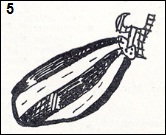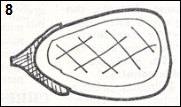with Elizabeth Andoh
The eggplant season is upon us and has been for a while now. They look so pretty stacked in their ¥100 piles, but if you live alone or your family is a small one, you often wonder what to do with them all.
The Japanese do many things with their nasu (eggplant) – they get pickled, put in soups, braised, sauted, fried, sauced and spiced.
Today’s recipes introduce three ways of serving up summer nasu. Any of these dishes if accompanied by rice or bread and a hearty salad could make an evening meal. Or, smaller portions could make interesting side dishes to a larger meal.
NASU NO HASAMI AGE (stuffed, fried eggplant)
ingredients:
- 6 medium-sized eggplants
- 200 grams ground beef
- 1/2 small onion
- 1 egg
- salt, pepper
- flour, bread crumbs
- oil for deep frying
- sprigs of parsley, lemon wedges
- soy sauce (for dipping)
instructions:
1. Wash the eggplants and pat dry. Trim the stems slightly and slice each eggplant in half, lengthwise Trim slivers off top and bottom of each half (illustration 1).
2. Slit each half lengthwise again to stem, but do not cut thru (illustration 2). Place paper towels inside “pocket” to keep the cut surface dry.
3. Saute finely minced onion in a little bit of oil. Let it stand until room temperature. Then add the onion, 1/2 of the egg (beaten), salt and pepper to the raw ground meat. Mix thoroughly and toss a bit of flour (no more than 1 teaspoon) over the meal filling and mix it in.
4. Lightly flour the inside of each eggplant “pocket” after removing the paper toweling. Then stuff each slice with 1/12 of the meat mixture (illustration 3).
5. Lightly flour the stuffed eggplants. Dip them in the remaining 1/2 egg (beaten with a drop or two of water) and then lightly coat them in bread crumbs.
6. Fry the eggplants in medium hot oil for about 3-4 minutes, turning several times to fry all surfaces. Drain off excess oil and serve hot with lemon wedges and parsley.
7. Figure 2-3 per serving. Dip stuffed eggplants in shoyu (soy sauce) after squeezing the lemon juice in it (known as “lemon-joyu“). One eats everything hut the tough stems.
notes:
1. There are baby eggplants (ko-nasu) available, too. If stuffing these, just slit them once up to, but not thru, the stems (illustration 4).
2. As a variation, you might try stuffing eggplants with shrimp: Chop 200 grams raw shrimp (shelled, called muki-ebi, and deveined) fairly fine and season with 1/2 teaspoon juice from grated fresh ginger and a drop or two of sake before adding 1/4-1/3 of a beaten egg and proceed as for above recipe.
* * *
NASU TO TORI NIKU NO TSUYA-NI (Glossy stewed eggplants and chicken)
ingredients:
- 4 medium-sized eggplants
- 200 grams chicken meat (without bone)
- a knob of fresh ginger-root
- 1 cup dashi
- 2 tablespoons sake
- 4 tablespoons shoyu
- 2 tablespoons sugar
- 1 teaspoon each cornstarch and cold water, mixed together oil for sauteing
instructions:
1. Combine 1 tablespoon each of the sake and shoyu in a small bowl. Peel and grate half of the fresh ginger root and add it to the bowl.
2. Cut up the chicken into rather small pieces. Marinate the chicken in the above marinade for about 10 minutes.
3. Wash and pat dry the eggplants. Cut off the stems and peel off zebra-like stripes, lengthwise (illustration 5). Then cut each eggplant into three or four section (illustration 6).
4. Heat several tablespoons of salad oil in a small fry pan and quickly saute the eggplant over medium heat. (This will help preserve the color and appearance as well as precook the eggplant). Drain the eggplant well.
5. Remove the chicken from its marinade, pat dry on paper towels and quickly saute in the remaining oil in the fry pan. When the chicken has turned white, remove and drain of excess oil.
6. In a separate saucepan heat 1 cup dashi to boiling and add 2 tablespoons sugar and 3 tablespoons shoyu. Peel and grate the remaining ginger root and add its juice to the saucepan.
7. Add the chicken and simmer, uncovered, over low heat for about 6-8 minutes. Add the eggplant and continue simmering for another minute or two.
8. Add previously mixed cornstarch and water, raise heat and stir until the sauce has thickened. Serve hot in individual small bowls.
notes:
1. fresh ginger root is called shoga
2. cornstarch is called either kon-sutachi (“western-style”) or katakuri-ko (“oriental-style”)
* * *
BEI-NASU NO MISO-AN-KAKE (eggplant with miso-meat sauce)
ingredients:
- 3 bei-nasu
- oil for deep frying
- 2 tablespoons Sendai miso
- 3 tablespoons sugar
- 3 tablespoons sake
- 100 grams sasami (chicken fillet)
- kozansho, sprigs of parsley
instructions:
1. Trim stem slightly and slice in half lengthwise each bei-nasu. Slice off just enough of the rounded bottom to allow the eggplant to lie still (illustration 7). Save these slivers for use in testing the heat of the frying oil.
2. With a grapefruit knife, carefully cut around the rim of the eggplant, about 1/4 inch from the skin. Don’t cut too deeply or puncture the skin. Then, with a regular knife, score the surface (illustration 8) but don’t allow the scorings to reach the outer rim. The score marks should be slightly deeper in the center area, shallower around the edges. These cuts and markings allow for better cooking and easier eating later.
3. Pat the eggplant dry, heat oil (test with the slivers from before; if the oil bubbles around the piece, the temperature is okay) and deep fry, skin side down, over medium-high heat. Push eggplant down under the oil momentarily. Fry for 3-4 minutes, then flip over and fry skin side up for 1 minute or until a toothpick can go easily thru skin and flesh.
4. Remove eggplant and drain very well (skin side up). Repeat until all have been fried (the average fry pan can hold 2 pieces at once).
5. Prepare the sauce (miso-an-kake) by combining the miso, sugar and sake, in a small saucepan. Stir over high heal until well mixed and slightly glossy. Remove from heat.
6. Chop sasami very firmly. Add to the miso sauce and return to low heat, stirring constantly. Raise heat slightly after 1 minute and continue cooking, stirring until the chicken meat has turned color and separated out into individual clumps.
7. To serve, place one of the fried eggplant halves, skin side down, on individual plates. Pour some of the sauce over the top (2-3 tablespoons per serving) and sprinkle with a pinch of konazansho. Garnish with a sprig of parsley. Serve with a spoon for easy eating. By the way, one does not usually eat the skin of these large eggplant.
notes:
1. bei-nasu (pronounced “bay”) means literally “American” eggplant. The name comes from the fact that this particular variation of the eggplant came originally from the West, although it has undergone considerable change. Sold in most vegetable stores for about ¥80-150 per piece (depending on size and season).
2. Sendai miso is but one of the hundreds (maybe even thousands) of types of miso (bean paste). It is dark in color and rather pungent in aroma. Check label with sales clerk when buying. A 500-gram plastic package will cost around ¥140. Refrigerated (and covered after opening) it will keep for months and months. I’ll be giving more recipes for using Sendai miso in later columns, so hold on to any left-overs.















